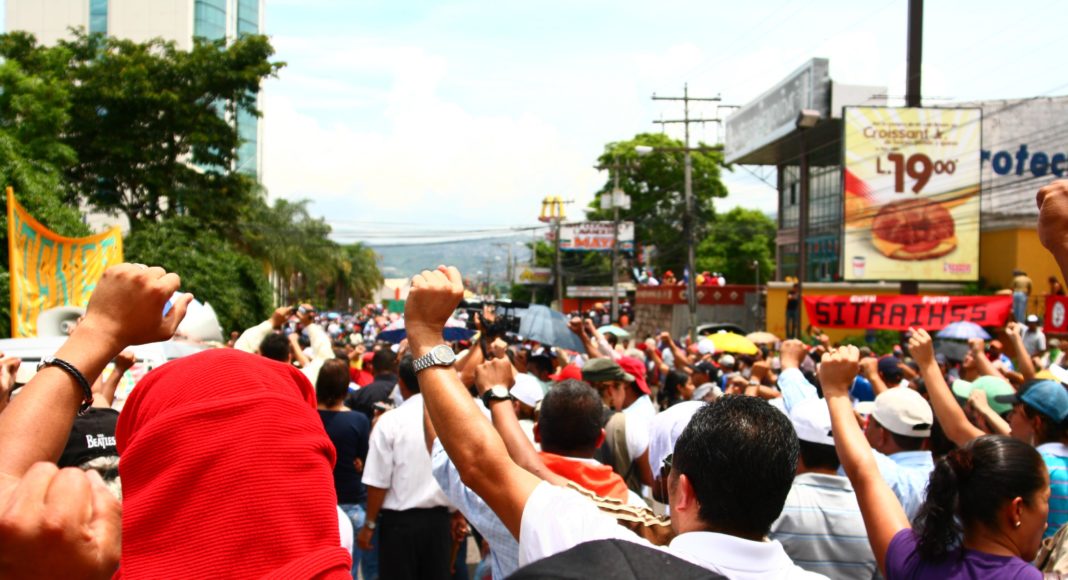On June 28, 2009, School of the Americas-trained general Romeo Vásquez Velasquez led the military coup that ousted Honduran President Manuel Zelaya. The plane that flew the president out of the country (lent by palm oil tycoon Miguel Facussé) stopped to refuel at the Soto Cano U.S. military base before depositing Zelaya — famously still in his pajamas — in Costa Rica.
The Honduran orchestrators of the coup and their Washington collaborators disingenuously justified the putsch by claiming Zelaya had broken the law by (among other things) attempting to modify the constitution to permit presidential reelection.
A lot has happened since that fateful day six years ago. We learned through Cablegate, for instance, that Facussé was known to the U.S. embassy since at least 2004 to be a drug trafficker. Since the coup Facussé was directly responsible for the murders of at least five (the number he admitted to on national television, an admission that did not even result in an investigation), and likely over 100 small farmers who challenged his claim to their collectively-held lands. Facussé died last week, having never answered for his crimes, at age 90.
Vásquez went on to run for president in the 2013 elections, in which the main opposition candidate was Xiomara Castro, former President Zelaya’s wife. Both lost to coup-backer Juan Orlando Hernández in an election riddled with fraud and violence and — we now know — tipped by the emptying of the Honduran Institute for Social Security (IHSS, a public health insurance program tied to certain forms of legal employment) coffers to finance the campaigns of Hernández and his fellow National Party candidates.
Like Facussé, Vásquez has not answered for his crimes in relation to the coup. He benefitted from the U.S.-created “Truth and Reconciliation Commission” which ensured immunity from prosecution to those who committed crimes during and in defense of the coup. Like most disasters these days, the coup was man-made, and has played out as a textbook example of disaster capitalism at its worst.
Meanwhile, Hillary Clinton has promoted her role in preventing Zelaya from returning to office as part of her hawkish electoral campaign strategy. And earlier this Spring, the Honduran Congress and Supreme Court overturned the Constitutional prohibition on reelection — the same prohibition used to justify ousting Zelaya (though he himself never attempted to change it).
But while tracing the trajectory of individual actors is important, it cannot adequately capture the scope  of the ongoing damage of the 2009 coup in Honduras. As I have argued previously, the main function of the coup was to open the floodgates for neoliberal plunder. Like most disasters these days, the coup was man-made, and has played out as a textbook example of disaster capitalism at its worst.
of the ongoing damage of the 2009 coup in Honduras. As I have argued previously, the main function of the coup was to open the floodgates for neoliberal plunder. Like most disasters these days, the coup was man-made, and has played out as a textbook example of disaster capitalism at its worst.
Post-coup Honduran regimes have taken a page out of the playbook of free market evangelist Grover Norquist—board member of the post-coup “Charter Cities” (ZEDE) initiative that promises to violently dispossess indigenous and other Honduran subsistence farmers of their lands to create corporate-governed cities within Honduran territory. In 2001 Norquist famously mused: “I don’t want to abolish government. I simply want to reduce it to the size where I can drag it into the bathroom and drown it in the bathtub.”
Since the coup, the Honduran public sector has been systematically starved through defunding and outright theft (as in the IHSS case) in order to render it weak enough for privatization. Of course, the usurpation of Honduran electoral democracy did not go uncontested. To the contrary; June 28, 2009, is also recognized as the day the most important Honduran social movement in over half a century — La Resistencia — was born. The National People’s Resistance Front (FNRP) arose spontaneously to protest the coup, bringing together indigenous and peasant organizations, student movements, unions, feminist and LGBT groups, and hundreds of thousands of previously unaffiliated Hondurans.
The over 4,000 human rights abuses documented by international human rights organizations in the months following the coup were carried out against its members, who continue to be systematically targeted for torture and assassination today. Over the past month, Hondurans have again engaged in mass protests, but with a different message than that of the Resistencia. In fact, the largely middle-class organizers of the torch-lit marches of los indignados (“the outraged”) have expressly prohibited FNRP members from carrying their flags (a prohibition FNRP members—many of whom are marching as indignados themselves—have fought).
The marchers, many of whom did not oppose the coup, decry corruption, and have been celebrated for promoting that message in the pro-coup corporate Honduran media. They demand the resignation of President Hernández, who as a candidate (while President of Congress), signed a USD$125 million contract with the company Dimesa overvaluing thousands of medicines to be purchased by IHSS — funds that later landed in his campaign coffers. They also demand the installation of a U.N.-led International Commission against Impunity in Honduras, and refuse to negotiate with the current corrupt administration.
First published by Telesur at www.teleSURtv.net/english

